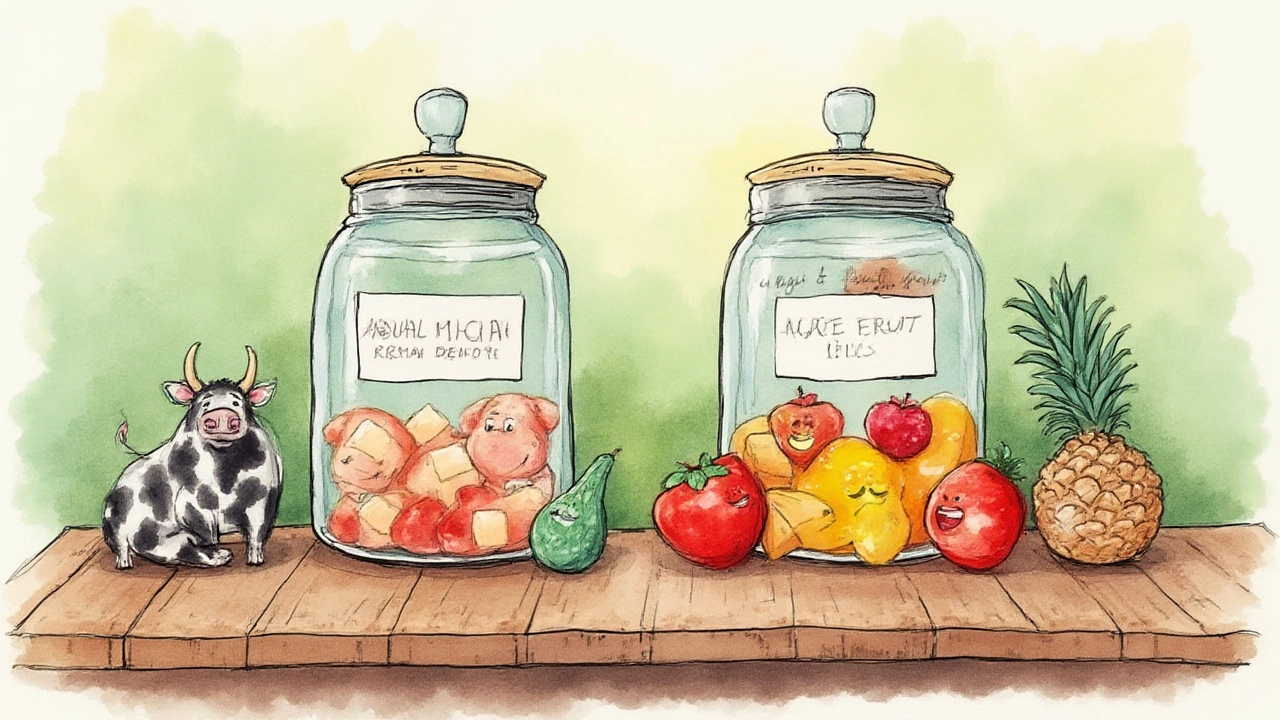
If you ever handed a bag of colorful jelly sweets to a vegan friend and saw a panicked look cross their face, you witnessed a classic sweet conundrum. Those cheerful gummies and chewy rings seem so innocent, but what’s actually inside them is a bit of a minefield if you’re trying to avoid animal products. I’ll be honest, when my cat Whiskers once tried to swipe a stray jelly bean, even I paused, wondering if it had the same sneaky ingredients hiding inside. So, can vegans actually enjoy jelly sweets without breaking the rules? Get comfy—there’s plenty of chewy detail ahead.
What Makes a Jelly Sweet Non-Vegan?
Here’s where it gets sticky. The classic texture of jelly sweets—the bouncy, squishy bite that’s miles away from the snap of a chocolate bar—comes from something called gelatin. And gelatin’s story isn’t sweet at all. It’s made by boiling animal skin, bones, or tendons, usually from pigs or cows, until you get a translucent, flavorless, gloopy substance. This goo is then dried and powdered, ready to set desserts, thicken soups, and—yep—give jelly sweets their famous wobble. Honestly, once you know what gelatin is, reaching for that next gummy bear doesn’t seem so appealing, right?
Even if you’re not vegan, the idea of crushed animal bits in your favorite candies is a bit of an appetite stopper. But for vegans, it’s a hard line: anything with animal parts, in any form, is a no-go. This means the majority of traditional jelly sweets, from cola bottles to fruit gums, start off disqualified. There’s no amount of label-squinting or wishful thinking that’ll change that. And it doesn’t stop at gelatin; less obvious ingredients sometimes sneak in too. You might spot beeswax giving candies their shine or shellac from insect resin making them glossy. E120 (carmine) is another party crasher—it’s a red coloring made by crushing up insects. So if you see “crushed bugs” or “animal bones” in that ingredient list, vegans need to steer clear.
All this means reading the ingredients on a candy packet is practically a survival skill if you’re vegan. Some countries force companies to list all animal-based ingredients, but in other places, it’s a guessing game. And candy companies love a cryptic label; something as vague as “gelling agent” or “natural colors” might hide animal sources. Wouldn’t it be easier if the bag just screamed “Not Suitable for Vegans!” in glow-in-the-dark letters? Until that glorious vision is reality, label vigilance is your best defense.
It’s wild how many candies you grew up eating without a second thought are off-limits. Think about the standard gummy bears, jelly babies, or even classic jelly beans. Some older formulations slip in confectioner’s glaze, which is never vegan. Brands that make jellied wine gums are notorious for this. I’ll admit, the hunt for a simple, guilt-free jelly sweet can get exhausting. But don’t hang up your sweet tooth just yet; there’s actually good news coming.

Plant-Based Alternatives: The Rise of Vegan Jelly Sweets
The candy scene isn’t stuck in the dark ages anymore. In the past decade, vegan options have exploded, and not just as bland copies. That wiggly texture we all want? Scientists, chefs, and candy-makers have discovered plant-powered stand-ins for gelatin that actually work. Agar-agar, a seaweed extract, is king when it comes to setting jellies. It’s completely vegan, and it’s popular in Asian cuisines for centuries. And guess what? It gives pretty much the same satisfying chew you get from classic sweets. If you pick up a vegan-friendly jelly, check the label for agar-agar. You’ll also find pectin (straight from fruit), carrageenan (another seaweed winner), and even starches like cornstarch or potato starch doing the heavy lifting.
Not all vegan sweets are created equal, though. Some are softer, some are extra chewy, and some pull off those crystal-clear colors brilliantly. There are even specialty brands that make nostalgia-inducing vegan takes on things like wine gums, gummy bears, and jelly babies. Just remember: “gelatine-free” doesn’t always mean vegan; you still want to scan for sneaky eggs, dairy, honey, shellac, or beeswax. My kitchen drawer is currently a crash test lab of various brands—I can name four off the top of my head that nail the texture and flavor just right. Look out for Candy Kittens (UK), which splash “vegan” right on the bag, or SmartSweets in the US for those looking for gummy rings made with chicory root fiber.
If you love making things from scratch, you can whip up your own jelly sweets. Most recipes use fruit puree, plant-based gelling agents, some sweetener, and a bit of patience. Agar needs a hot liquid to dissolve, but once it sets, you get a clean, firm, plant-based chew. Pectin’s a winner for those jammy-fruit flavors, and you’ll find endless recipes online adapted for vegans. I made a batch last winter with frozen raspberries, lemon, and agar—they disappeared faster than I’d like to admit (okay, Whiskers did try to swipe one, but I promise there’s no cat-safe version).
- vegans reading this don’t need to miss out: there’s usually a vegan version of every classic jelly sweet, if you poke around the right shops or sites.
- If you love old-school candies, brands like Biona, Jealous Sweets, and YamYam have nailed vegan-friendly jelly textures and flavors.
- Organic or health stores tend to have more vegan-certified sweet brands. Look for "Vegan" logos.
- Asian markets often stock agar strips and powders for DIY home candy making.
- Watch out for hidden animal-based colorings, especially reds. Beetroot and anthocyanins are safe, carmine is not.

How to Spot Vegan Sweets and Avoid the Pitfalls
Okay, you’ve got the urge for jelly sweets, but you’re standing in the candy aisle, totally stumped by a list of unfamiliar ingredients. Don’t just trust marketing. “Gelatine-free” means there’s no gelatin, sure, but it could still sneak in honey, dairy, shellac, or non-vegan colors and flavorings. Here’s a simple survival guide for vegan sweet shopping:
- Start by flipping the bag over and scanning for the word “vegan.” Reputable brands will display it clearly on the front or back if it applies.
- For unmarked products, get comfortable with label detective work. Words like “gelatine, carmine (E120), shellac, beeswax, honey, dairy, or confectioner's glaze” mean nope.
- Pectin, agar-agar, carrageenan, potato starch, and corn starch are green lights. They’re all 100% plant-based gelling or thickening agents.
- Color and flavor sound innocent, but dig deeper; “natural flavors” can hide anything unless specified as plant-derived. “Plant extract” or “fruit juice” is your friend here.
- Check allergy info, too—if a jelly sweet “may contain milk or eggs” due to cross-contact, some strict vegans still avoid it, others don’t mind.
Technology has thankfully made this process easier. There are some great barcode-scanning apps out there—search for vegan product checkers. You just scan the packaging and the app reveals if it’s safe. If in doubt, most vegan online forums and sites keep updated lists of candy brands that pass the test. Never be afraid to email a manufacturer, either. They expect ingredient questions and usually answer fast. Some mainstream brands have even changed ingredients to appeal to the vegan market—Starburst chews in the UK went vegan in recent years, for example.
If you’re eating out, though, and someone offers you an unlabelled jelly sweet, your best defense is a polite “No, thanks.” Unless you know the brand or you trust the source, it’s not worth the risk. Even in goodie bags at parties or work events, it pays to stick to snacks where you’re confident about the ingredients. Hidden gelatin and animal coloring slip into so many bulk candies it’s wild.
For those looking for special treats or gifts, online vegan candy shops are out there with categories like “gummies, jelly sweets, and chews.” The choice gets better every year. Expect more wild shapes and flavors as plant-based candy tech evolves. I’ve taste-tested watermelon slices, sour worms, fizzy cola bottles, and even jelly-foam “shrimp”—all certified vegan and mind-blowingly close to childhood classics.
If you love crafts, the DIY path opens up flavor combinations you wouldn’t find in shops. Think strawberry-basil jellies or apple-ginger chews—if you can blend it, you can turn it into a sweet. Try experimenting with different gelling agents and sugar types until you hit your personal texture jackpot. It’s a game of trial and error, sure, but when you nail that first perfect vegan jelly sweet, it’s a whole vibe.
So, no, vegans can’t eat standard jelly sweets—but that doesn’t mean they’re doomed to a candy-free life. With some label savvy, a bit of home cooking, or a well-chosen online order, anyone can nosh on chewy, wobbly, fruity sweets with zero animal guilt. Just watch out for Whiskers stealing yours off the kitchen counter—cat paws don’t care about plant-based gelling agents!





